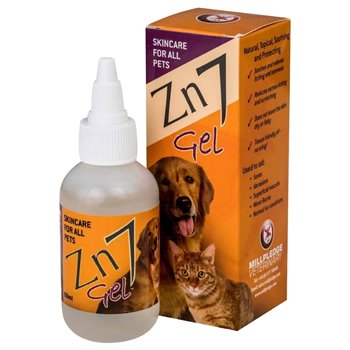Sore Skin in Cats
Sore skin in cats is a common condition that can cause visible irritation, discomfort, and behavioural changes. It may appear as redness, scabs, hair loss, or inflamed areas on the skin. Cats often scratch, lick, or bite the affected regions, which can worsen the irritation and lead to infection if not managed properly. Understanding the possible causes and treatment options is important in helping your cat recover and stay comfortable.
Common Causes of Sore Skin
Sore skin can develop for many reasons. One of the most frequent causes is flea bites. Even a single flea can trigger an allergic reaction known as flea allergy dermatitis in cats, resulting in intense itching and inflamed skin. Mites and lice can also cause irritation, particularly around the ears, neck, and base of the tail.
Allergies to food or environmental factors are another major cause. Some cats react to ingredients in their diet, such as c...
Sore Skin in Cats
Sore skin in cats is a common condition that can cause visible irritation, discomfort, and behavioural changes. It may appear as redness, scabs, hair loss, or inflamed areas on the skin. Cats often scratch, lick, or bite the affected regions, which can worsen the irritation and lead to infection if not managed properly. Understanding the possible causes and treatment options is important in helping your cat recover and stay comfortable.
Common Causes of Sore Skin
Sore skin can develop for many reasons. One of the most frequent causes is flea bites. Even a single flea can trigger an allergic reaction known as flea allergy dermatitis in cats, resulting in intense itching and inflamed skin. Mites and lice can also cause irritation, particularly around the ears, neck, and base of the tail.
Allergies to food or environmental factors are another major cause. Some cats react to ingredients in their diet, such as certain proteins or additives. Others may be sensitive to pollen, dust mites, or household cleaning products. When the immune system reacts to these substances, it can lead to persistent skin inflammation.
Skin infections caused by bacteria or fungi are also common. These may occur after scratching or when the skin’s natural barrier is weakened. In some cases, ringworm, a fungal infection, can cause round patches of hair loss and redness. Hormonal imbalances, such as thyroid or adrenal gland issues, can also affect skin health.
Stress and behavioural problems can contribute to sore skin as well. Cats sometimes over-groom due to anxiety or boredom, creating bald spots or wounds. Pain from another underlying condition may also cause a cat to lick or scratch excessively.
Recognising the Symptoms
Cats with sore skin may show clear signs of discomfort. Excessive scratching, licking, or rubbing against furniture is often the first indication. Red or inflamed patches, crusts, and hair loss may develop over time. In severe cases, the skin can break open, forming sores or scabs that may ooze. Some cats become restless or withdrawn, and their coat may lose its shine.
It is important to check your cat’s skin regularly, especially if they are prone to allergies or spend time outdoors. Focus on areas around the neck, back, belly, and tail base, as these are commonly affected. If you notice swelling, strong odour, or thickened skin, professional assessment is advised.
Diagnosis and Veterinary Care
A veterinary examination is essential to determine the cause of sore skin. The vet may carry out a physical inspection, skin scrapings, or blood tests to identify parasites, infections, or allergic reactions. In some cases, an elimination diet or allergy testing may be recommended to pinpoint triggers.
Once the cause has been identified, treatment can begin. Flea control products are often prescribed for cases involving parasites. These may include topical treatments, oral medications, or flea collars. If a bacterial or fungal infection is present, antibiotics or antifungal medications may be required.
When allergies are the main factor, your vet may suggest a change in diet or the use of hypoallergenic food. Anti-inflammatory medication, soothing shampoos, and topical creams can also help reduce itching and inflammation. Cats with severe allergies might benefit from long-term management plans involving regular check-ups and skin care routines.
Home Care and Prevention
Maintaining good skin health at home can make a significant difference. Regular grooming helps remove loose fur, dirt, and potential allergens. It also allows early detection of any unusual patches or irritations. Using gentle, cat-safe shampoos can help clean and soothe the skin, but bathing should not be excessive as it can strip away natural oils.
Flea prevention should be maintained throughout the year, even for indoor cats. A consistent schedule of flea control treatment can prevent future outbreaks and discomfort. The environment should also be cleaned regularly, including bedding, carpets, and furniture, to remove flea eggs and allergens.
A balanced diet supports healthy skin and coat condition. Foods rich in omega-3 and omega-6 fatty acids can improve moisture balance and reduce inflammation. Ensuring your cat has fresh water and a calm environment can also help reduce stress-related over-grooming.
In multi-cat households, monitoring interactions is important, as stress from social tension can sometimes lead to skin issues. Providing safe spaces and enrichment, such as scratching posts and toys, encourages natural behaviour and helps maintain overall well-being.
Sore skin in cats should always be taken seriously. Early identification and treatment can prevent complications and improve comfort. Regular veterinary advice, combined with good home care, helps ensure your cat maintains healthy skin and a comfortable life.








